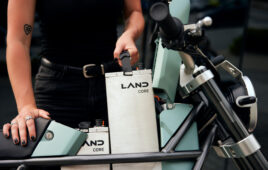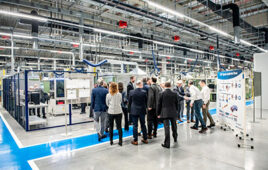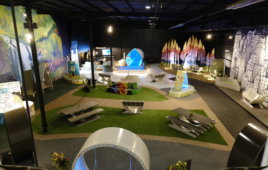By Leslie Langnau
 Early in the 3D printing industry, there were efforts to take wood byproducts and use that material to make parts. These early efforts were interesting for the novelty.
Early in the 3D printing industry, there were efforts to take wood byproducts and use that material to make parts. These early efforts were interesting for the novelty.
Today, however, there’s a more serious effort to turn wood into a usable 3D printable material. Desktop Metal launched Forust, a process to sustainably produce functional end-use wood parts using its single pass binder jetting AM technology. The Forust process upcycles waste byproducts from wood manufacturing (cellulose dust) and the paper industry (lignin) and re-materializes functional wood parts through high-speed 3D printing including digital grain throughout the part.
While primarily aimed at architects and designers of custom wood pieces for home decor, interiors, transportation, and architectural design, this development shows the flexibility of 3D printing/additive manufacturing technology and how it can be used to solve some environmental issues.
William McDonough, architect, globally recognized leader in sustainable development and design, and pioneer of the concepts of Cradle to Cradle, the Circular Economy, and the Circular Carbon Economy, said, “The Forust technology allows us to take something that was previously wood waste and re-materialize it into exquisitely beautiful and useful things. We are honoring the cellulose and lignin of the trees by rearticulating them into assets for present and future generations. By allowing millions of trees to remain in place in their forests, Forust is launching a highly evolved technology for the circular technosphere that supports and celebrates stewardship of the natural, regenerative, and diverse biosphere, making it not only smart, but wise. This is an historic and material opportunity in the history of design and the making of things that reminds me of Arthur C. Clarke’s famous quote, ‘Any technology that is sufficiently advanced is indistinguishable from magic.’ As a lover of wood and forests, I find Forust indistinguishable from magic. The 3D printing of wood using waste natural materials is a gamechanger. We have only begun to explore its beneficial potentials, but it is clear they are immense.”
Transforming wood byproducts
Forust is led by industry veteran and ceramics 3D printing pioneer, Andrew Jeffery, who previously served as President of Boston Ceramics. Jeffery is joined by co-inventors and creative consultants in industrial design, Virginia San Fratello, Chair of the Department of Design at San Jose State University, and Ronald Rael, Professor and Chair of the Department of Architecture at the University of California Berkeley, both of whom are also founding partners of 3D printing company, Emerging Objects.
“The inspiration for Forust was to begin with sawdust and end with forests,” said Jeffery. “Our process is based on extensive research conducted over the past decade in the field of hardwood lumber, leading to complex and elegant finished structures. Through advanced CAD software, proprietary materials and Desktop Metal binder jetting mass production platforms, we can now manufacture beautiful, functional and innovative wood products for a variety of architectural, interior, and home goods applications from upcycled wood byproducts.”
The Forust process combines two waste streams from traditional wood production, sawdust and lignin, to sustainably produce isotropic, high-strength wood parts. Depending on the size of the parts, Forust can manufacture wood products using either the Shop System or a custom version of the new RAM 336 3D printer, which supports prints up to two cubic meters in volume at speeds in excess of 100 liters of parts per hour.
During the printing process, layers of specially treated sawdust are spread and selectively joined by a non-toxic and biodegradable binder. Digital grain is printed on every layer and parts can then be sanded, stained, polished, dyed, coated and refinished in the same manner as traditionally manufactured wood components.
“Forust offers nearly unlimited design flexibility,” said Jeffery. “From exotic grain structures to grainless wood, we can digitally reproduce wood textures and a myriad of grain types. And, because they are made from a wood and bioresin compound, these parts exhibit the functionality and stiffness in line with conventional wood. Our finished pieces are indistinguishable from traditionally manufactured wood products you would find in a store. The additive manufacturing process literally becomes invisible.”
Because Forust produces parts additively layer by layer without the need for supports, designers have the freedom to create complex features and iconic designs that would be difficult or impossible to produce with traditional woodworking methods.
Unlike particle board or laminate, Forust produces a wooden part with a digital grain that flows throughout the entire part that can be sanded and refinished. Software has the ability to digitally reproduce nearly any wood grain, including rosewood, ash, zebrano, ebony and mahogany, among others. Parts will also support a variety of wood stains at launch, including natural, oak, ash, and walnut.
Forust also offers an on-demand manufacturing service where manufacturers and designers can submit their own custom designs for printing, order samples or pursue high-volume partnerships to produce custom, 3D printed wood pieces in volume for use in their products.
“We want to make it easy for designers to explore complex new geometries for a variety of products and applications using an age-old material,” said Jeffery. “At the end of the wood product’s life, we would like to see customers have two choices — dispose of it and it will biodegrade over time as any wood product would, or shred it and repurpose the material into future parts through Forust. Our vision is a true circular manufacturing process.”
“Applications for Forust’s wood parts are really limitless,” said Ric Fulop, Founder and CEO of Desktop Metal. “There are many applications where polymers and plastics are used today where you can now cost-effectively replace with sustainably manufactured wood parts – luxurious, high-end components in interiors, consumer electronics, instruments, aviation, boats, home goods and eventually in flooring and exterior roofing applications. For the first time, we can produce beautiful parts with the same durability and characteristics you would have in traditionally manufactured wood, but printed using upcycled materials which does not require cutting down or harvesting trees. With Forust, we have the opportunity to have a meaningful impact on sustainability, climate change and waste issues that we as a humanity have brought to the planet. For each tree saved, we are reducing the carbon footprint by a metric ton over its lifetime.”
Forust
www.forust.com
Desktop Metal
www.desktopmetal.com
Filed Under: Green engineering • renewable energy • sustainability




